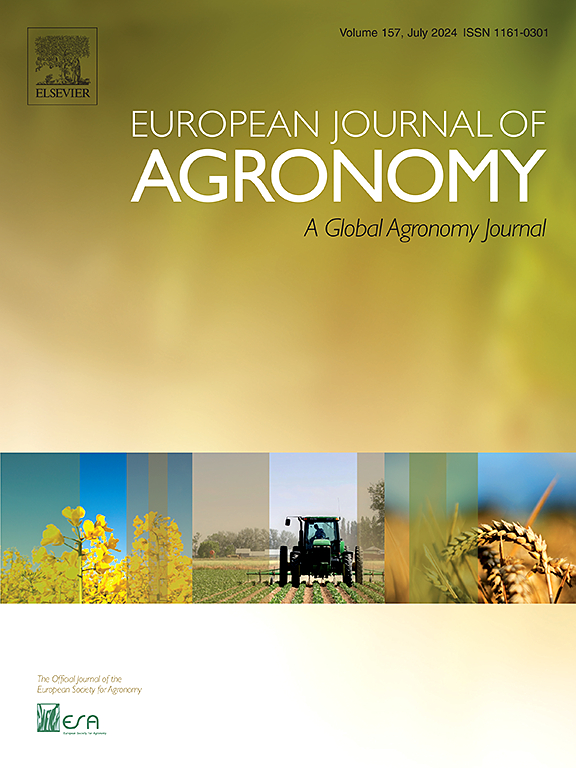Machine learning-driven analysis of greenhouse gas emissions from rice production in major Chinese provinces: Identifying key factors and developing reduction strategies
IF 4.5
1区 农林科学
Q1 AGRONOMY
引用次数: 0
Abstract
Rice cultivation is a significant contributor to global greenhouse gas (GHG) emissions. However, the complex nonlinear relationship between driving factors and GHG emission intensity (GHGI) remains poorly understood, and effective reduction strategies are still needed. This study integrates machine learning models and SHapley Additive Explanations (SHAP) to assess the nonlinear relationship and design GHGI reduction strategies based on data from 14 provinces in China from 2012 to 2022. The key findings are as follows. (1) For GHGI reduction, the optimal conditions include an annual average sunshine duration of 47–75 days, an annual average temperature of 15.3–17.9℃, annual average precipitation levels of either 1000.0–1368.4 or 1680.0–2004.7 mm, soil pH below 5.6 or above 6.5, soil total nitrogen content of 17.0–20.3 g/kg, and soil organic carbon content of 15.0–22.5 g/kg. The recommended application rates for nitrogen, phosphate, and potassium fertilizers are 160.0–311.0 kg/ha, 124.9–129.9 kg/ha and 144.0–194.3 kg/ha, respectively. Agricultural practices such as transplanting, mixed farming, tillage and mid-season drainage demonstrate higher GHGI reduction potential compared to other measures. (2) For lowest-cost GHGI reduction strategies in major provinces, Heilongjiang, Jilin, and Liaoning provinces could reduce GHGI to 0.28, 0.15, and 0.05 tCO2e/t, respectively, by adjusting sunshine conditions. Hainan, Guangdong, Fujian, Jiangsu, Jiangxi, Zhejiang and Guangxi provinces could achieve GHGI reductions to 0.62, 0.31, 0.21, 0.47, 0.57, 0.92 and 0.28 tCO2e/t, respectively, by optimizing nitrogen fertilizer application and labor practices. Hunan and Anhui provinces could reduce GHGI to 0.57 and 0.85 tCO2e/t by adjusting irrigation modes. Implementing these strategies would result in an average GHGI reduction of 28.75 %, although production costs per mu for early, mid-to-late indica and japonica rice in major provinces would increase by 28.87 %, 27.95 % and 27.38 %, respectively, compared to the original production costs. These findings provide valuable insights and a scientific basis for developing GHGI reduction strategies in rice production and enhancing the sustainability of this critical agricultural sector.
中国主要省份水稻生产温室气体排放的机器学习驱动分析:确定关键因素并制定减排策略
水稻种植是全球温室气体(GHG)排放的重要来源。然而,驱动因素与温室气体排放强度(GHGI)之间复杂的非线性关系尚不清楚,仍然需要有效的减排策略。本研究基于2012 - 2022年中国14个省份的数据,将机器学习模型与SHapley加性解释(SHAP)相结合,评估非线性关系并设计温室气体减排策略。主要发现如下。(1)减少GHGI的最佳条件为年平均日照时数47 ~ 75 d,年平均气温15.3 ~ 17.9℃,年平均降水量1000.0 ~ 1368.4 mm或1680.0 ~ 2004.7 mm,土壤pH≤5.6或≥6.5,土壤全氮含量17.0 ~ 20.3 g/kg,土壤有机碳含量15.0 ~ 22.5 g/kg。氮肥、磷肥和钾肥的推荐施用量分别为160.0 ~ 311.0 kg/ha、124.9 ~ 129.9 kg/ha和144.0 ~ 194.3 kg/ha。与其他措施相比,移栽、混合耕作、耕作和季中排水等农业做法显示出更大的温室气体减排潜力。(2)对于最低成本的温室气体减排策略,黑龙江省、吉林省和辽宁省通过调整日照条件可将温室气体排放量分别降低至0.28、0.15和0.05 tCO2e/t。海南、广东、福建、江苏、江西、浙江和广西通过优化氮肥施用和劳动方式,温室气体排放量可分别减少0.62、0.31、0.21、0.47、0.57、0.92和0.28 tCO2e/t。湖南省和安徽省通过调整灌溉方式,可将GHGI降低至0.57和0.85 tCO2e/t。实施这些战略将使温室气体排放指数平均降低28.75 %,但主要省份的早稻、中晚籼稻和粳稻的亩产成本将分别比原生产成本提高28.87 %、27.95 %和27.38 %。这些发现为制定水稻生产中的温室气体减排战略和提高这一关键农业部门的可持续性提供了宝贵的见解和科学基础。
本文章由计算机程序翻译,如有差异,请以英文原文为准。
求助全文
约1分钟内获得全文
求助全文
来源期刊

European Journal of Agronomy
农林科学-农艺学
CiteScore
8.30
自引率
7.70%
发文量
187
审稿时长
4.5 months
期刊介绍:
The European Journal of Agronomy, the official journal of the European Society for Agronomy, publishes original research papers reporting experimental and theoretical contributions to field-based agronomy and crop science. The journal will consider research at the field level for agricultural, horticultural and tree crops, that uses comprehensive and explanatory approaches. The EJA covers the following topics:
crop physiology
crop production and management including irrigation, fertilization and soil management
agroclimatology and modelling
plant-soil relationships
crop quality and post-harvest physiology
farming and cropping systems
agroecosystems and the environment
crop-weed interactions and management
organic farming
horticultural crops
papers from the European Society for Agronomy bi-annual meetings
In determining the suitability of submitted articles for publication, particular scrutiny is placed on the degree of novelty and significance of the research and the extent to which it adds to existing knowledge in agronomy.
 求助内容:
求助内容: 应助结果提醒方式:
应助结果提醒方式:


